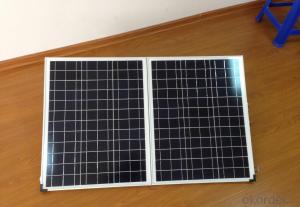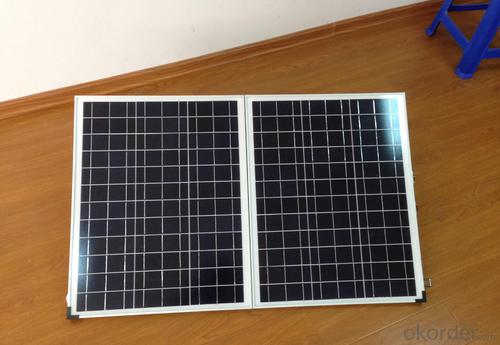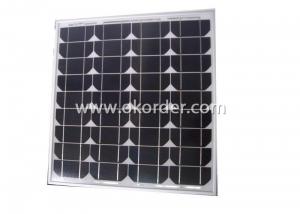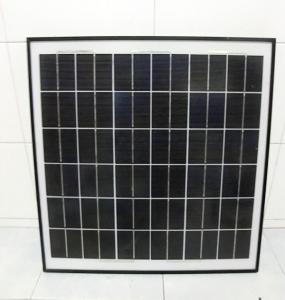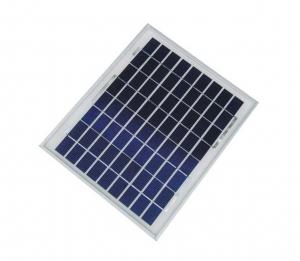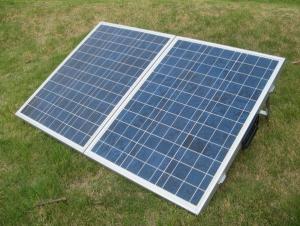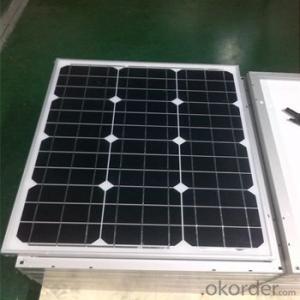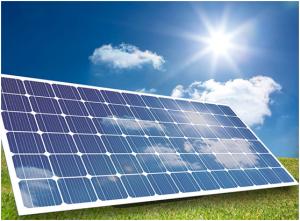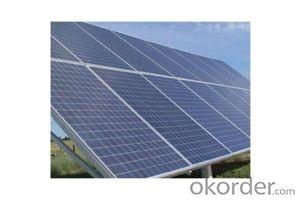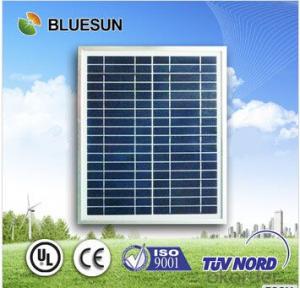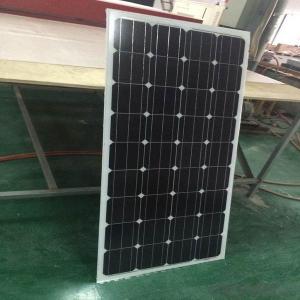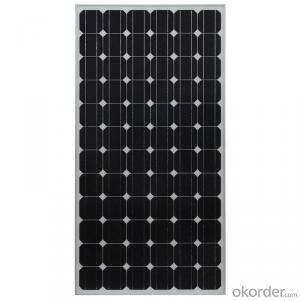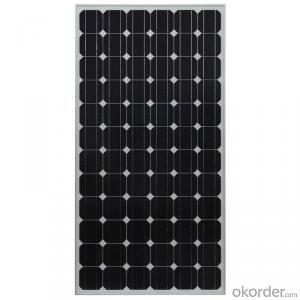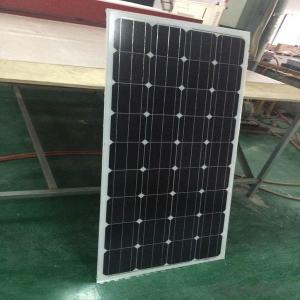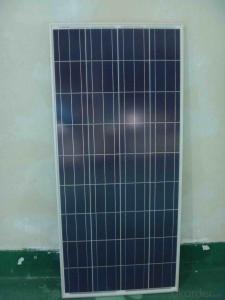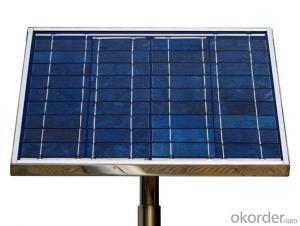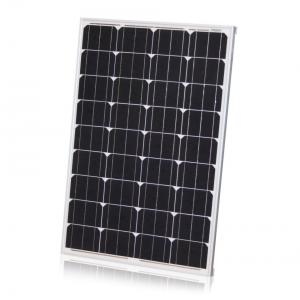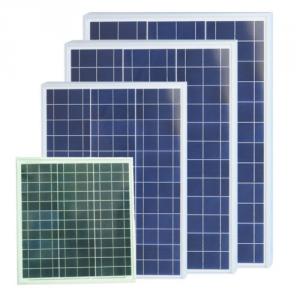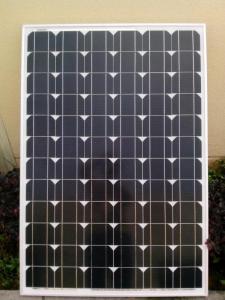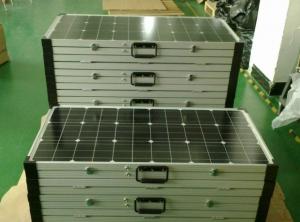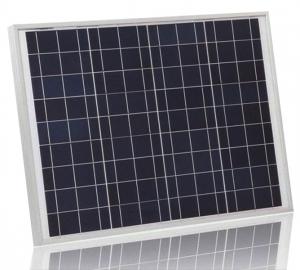Best Price 210W Mono Solar Panels Made in China for Sale
- Loading Port:
- Shanghai
- Payment Terms:
- TT OR LC
- Min Order Qty:
- 1000 watt
- Supply Capability:
- 1000000 watt/month
OKorder Service Pledge
OKorder Financial Service
You Might Also Like
Specification
Product Description
Solar module/panel with high efficiency solar cells
Strong, lightweight aluminum frame design with reinforced sealing and load hold to prevent freezing and warping, and stand against high wind.
Under Standard Test Conditions(STC): Irradiance of 1000W/m2, Am1.5 and 25º C cell temperature.
Mechanical Characteristics
Dimensions: 996mm(L) x 1460mm(W) x 40mm(H)
Weight: 14.5kg
Solar Cells: Polycrystalline solar cells, 36 cells
Construction: Front: High-transmission 3.2mm tempered glass; Encapsulate: EVA; Back: TPT
Frame: Clear anodized aluminum alloy Color: Silver
Product features:
1. The modules use high-quality imported polycrystalline or monocrystalline solar cells;
Enclosed by high-rigidity tempered glass, with excellent light transmittance and output performance;
2. Surface treated with reflection-reducing process, increasing the light absorption.
Back sealed with anti-aging EVA, resistant from moisture and corrosion.
3. The efficiency of our monocrystalline solar cell is over 17%, and polycrystalline panel is over 16%. We stipulate, the allowance of each panel's rated power has to be positive. Each panel is strictly tested before leaving the factory.
4. Our solar panel is designed with a lifetime of 25 years, and guaranteed that the power decline less than 10% within 10 years, and 20% within 20 years.
| Performance | |
| Rated Power[Pmax] | 210W |
| Power Tolerance | ± 3% |
| Nominal Voltage | 29.6V |
| Design Life | 25 years |
| Electrical Characteristics | |
| Maximum Power [Pmax] | 210W± 3% |
| Maximum Power Voltage [Vmp] | 29.6V± 3% |
| Maximum Power Current [Imp] | 7.44A± 3% |
| Short-Circuit Current [Isc] | 7.82A± 3% |
| Open-Circuit Voltage [Voc] | 35.9V± 3% |
| Current Temperature Coefficient | 0.08%/º C |
| Voltage Temperature Coefficient | - 0.32%/º C |
| Power Temperature Coefficient | -0.38%/º C |
- Q: What is the average size of a residential solar panel system?
- The average size of a residential solar panel system is typically between 5 to 10 kilowatts (kW), depending on the energy needs and available rooftop space of the home.
- Q: If I wanted to add solar panels to my home to produce on average, 8 kWh of electricity daily, how much do you estimate it would cost using state of the art technology?I live in Virginia (Washington DC Metro Area), and I have Dominion Power. I pay the following electric rates:Jun-Sep $0.0904/kWhOct-May $0.0776/kWhAnnual Ave: $0.0824/kWhDistribution charges add on approximately another $0.0228/kWh.How long would the ROI for an 8 kWh/day solar system be?
- Figure 8 hours of sun per day, so 8 kW-hr is a rate of kW, which is a medium sized panel, probably not enough to operate your house totally, unless you have a very small unit. Averaged over 24 hours, that is power at a rate of only 300 watts, enough for a TV. Average US home use is .2 kW, which over 24 hours is 29 kW-hr, plus you need extra for cloudy days, peak demands, and to charge batteries. You have to decide off-grid or on-grid, and if you want to (and are allowed to) sell excess power to the power company. Off gird, the cost of batteries and charge controller are a large part of the cost. On-grid, you have to purchase equipment approved by the power company to match your power with the grid. Panels will cost about $3 per watt, so for 000 watts that is $3000. Double that for installation, then add in cost of charge controller, inverter, batteries, etc. The last items depend on your alternatives, see paragraph above. .
- Q: Can solar panels be installed on water treatment plants or utilities?
- Yes, solar panels can be installed on water treatment plants or utilities. In fact, many water treatment plants and utilities are increasingly adopting solar energy systems to reduce their reliance on traditional energy sources and lower their carbon footprint. Solar panels can be installed on the roofs of these facilities or on nearby open spaces to generate clean and renewable electricity to power their operations.
- Q: How much space do solar panels require?
- The space required for solar panels depends on several factors such as the power output of the panels and the efficiency of the solar cells. On average, a typical solar panel requires around 10-20 square feet of space. However, it is important to note that solar panels can be mounted on rooftops, installed in large solar farms, or even integrated into building materials, allowing for flexibility in their placement and utilization of available space.
- Q: Can solar panels be installed on bus stops or shelters?
- Yes, solar panels can be installed on bus stops or shelters. This allows them to generate electricity from sunlight, which can be used to power lighting, signage, and other amenities at the bus stops or shelters. It also helps in reducing reliance on grid electricity and promotes the use of renewable energy sources.
- Q: Can solar panels be installed on a fire station or emergency services building?
- Yes, solar panels can be installed on fire stations or emergency services buildings. In fact, many fire stations and emergency services buildings have already adopted solar energy to reduce their carbon footprint and save on energy costs. The ample roof space available on these buildings makes them ideal candidates for solar panel installation. Additionally, the use of solar power can provide backup power during emergencies, ensuring uninterrupted services even during power outages.
- Q: I live in Los Angeles area, I see the ads that, they will install solar panel for $0. I would like to know what is the catch ?Thanks You.
- using solar panel in your life, you can save the electricity bill, also you are saving energy for our later generations. If more and more people are using solar energy, the mother earth will become more beautiful.
- Q: What do these mean? I'm interested in doing a solar panel project. The problem is I know nothing about electricity, wiring, or panels so I've bought a small panel to experiment with first.I don't know what amps, watts, or volts are; what I should be reading on the batteries I will be charging? Or on the small appliances I will be running?The panel I bought has four settings:. 3V ---- 200mA2. 6V ---- 00 mA3. 9V ---- 50mA4. 2V ---- 50 mA(What is mA?)Also, will you give examples of what I can run with this? Make up any scenarios with whatever amps/volts/watts.
- okorder / to see our solar panel project.
- Q: What is the working principle of solar panels?
- Based on the above considerations, silicon is the most ideal solar cell materials, which is the main reason for solar cells to silicon-based. But with the continuous development of new materials and related technology development, to other village-based solar cells are increasingly showing attractive prospects.
- Q: How do solar panels impact the environment?
- Solar panels have a positive impact on the environment as they generate clean and renewable energy without emitting greenhouse gases or other pollutants. They help reduce our reliance on fossil fuels, decrease air pollution, and mitigate climate change by curbing carbon emissions. Additionally, solar panels require minimal water usage compared to other energy sources and have a long lifespan, making them an environmentally sustainable solution for electricity generation.
Send your message to us
Best Price 210W Mono Solar Panels Made in China for Sale
- Loading Port:
- Shanghai
- Payment Terms:
- TT OR LC
- Min Order Qty:
- 1000 watt
- Supply Capability:
- 1000000 watt/month
OKorder Service Pledge
OKorder Financial Service
Similar products
Hot products
Hot Searches
Related keywords
